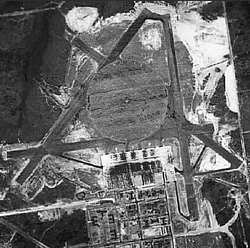But Main Criteria Seems To Be 'Paying Passengers' Boarded At
Airports
 Here we go again. Another report
that takes a shot at funding for airports that aren't primarily
focused on airlines. According to Subsidyscope, an initiative of
the Pew Economic Policy Group, the federal government has funded
more than 3,100 airport construction and rehabilitation projects
costing nearly $2 billion from 2005-2009, despite the fact they
received priority ratings well below the FAA's threshold for
projects consistent with national goals and objectives, according
to Pew's analysis.
Here we go again. Another report
that takes a shot at funding for airports that aren't primarily
focused on airlines. According to Subsidyscope, an initiative of
the Pew Economic Policy Group, the federal government has funded
more than 3,100 airport construction and rehabilitation projects
costing nearly $2 billion from 2005-2009, despite the fact they
received priority ratings well below the FAA's threshold for
projects consistent with national goals and objectives, according
to Pew's analysis.
Pew says the data was compiled and released Wednesday from the
FAA's new searchable database which shows National Priority Ratings
(NPRs) -- self-assigned by FAA -- for every airport that received a
grant under the agency's Airport Improvement Program (AIP) over the
last five years.
Subsidyscope analysis also reveals that a number of small
airports that accommodate as few as one paying passenger each year
received significant amounts of federal funding from AIP. The three
airports with the highest AIP funding per enplanement, or paying
passenger, are Fall River Mills Airport (CA) $271,825, Cecil Field
(FL) $270,063 and Marana Regional (AZ) $235,306.
(Editor's Note: Cecil Field (aerial view
below), which is practically in ANN's back yard, is hardly a "small
airport." It is a former Navy Master Jet Base closed by BRAC and
handed over to the city of Jacksonville, Florida. It accounts for
hundreds of jobs, a Florida State College aviation educational
program, and is often discussed as a critical element in a regional
intermodal transportation system that will help sustain the economy
in NE Florida for decades to come. Is that "small airport" worth
$270,063? We'll let you decide.)

Pew says the AIP funds projects that are meant to enhance
safety, protect the environment or otherwise improve the nation's
aviation system. Funded principally by revenue from ticket and fuel
surcharges, and therefore largely by passengers using large
commercial airports, the program disbursed $3.5 billion in grants
last year. However in fiscal year 2007, these large and medium hubs
received only 33 percent of AIP funding, while smaller commercial
and GA airports received 64 percent. GA received nearly 25 percent
of the funding.
In terms of sheer dollars awarded, Los Angeles International
Airport fared best during the five-year period, receiving $280
million through the AIP. It was followed by Chicago's O'Hare
International Airport ($262 million), Seattle-Tacoma International
Airport ($235 million) and Hartsfield-Jackson Atlanta Airport ($209
million).
We would note, again, that the role played by smaller commercial
and GA airports in the national airport system is vital to making
things run well at those major airports. Without them, either the
traffic mix at the majors would cause unbelievable congestion, or
GA would be pushed out altogether. In addition, the national
airport system allows business people to go places that airlines
just can't or won't serve, provide vital training facilities, and
in general are a net plus to the nation's economy for a very minor
investment on a per-airport basis. The National Airport System is
just that, a system. Not simply a handful of large airports served
by major airlines -- (Ed).
 ANN's Daily Aero-Linx (05.06.25)
ANN's Daily Aero-Linx (05.06.25) ANN's Daily Aero-Term (05.06.25): Ultrahigh Frequency (UHF)
ANN's Daily Aero-Term (05.06.25): Ultrahigh Frequency (UHF) ANN FAQ: Q&A 101
ANN FAQ: Q&A 101 Classic Aero-TV: Virtual Reality Painting--PPG Leverages Technology for Training
Classic Aero-TV: Virtual Reality Painting--PPG Leverages Technology for Training Airborne 05.02.25: Joby Crewed Milestone, Diamond Club, Canadian Pilot Insurance
Airborne 05.02.25: Joby Crewed Milestone, Diamond Club, Canadian Pilot Insurance




